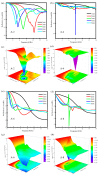Electromagnetic Wave-Absorption Properties of FDM-Printed Acrylonitrile-Styrene-Acrylate/Multi-Walled Carbon Nanotube Composite Structures
- PMID: 40808059
- PMCID: PMC12349283
- DOI: 10.3390/polym17152010
Electromagnetic Wave-Absorption Properties of FDM-Printed Acrylonitrile-Styrene-Acrylate/Multi-Walled Carbon Nanotube Composite Structures
Abstract
The growing need for lightweight, customizable electromagnetic wave absorbers with weather resistance in aerospace and electromagnetic compatibility applications motivates this study, which addresses the limitations of conventional materials in simultaneously achieving structural efficiency, broadband absorption, and environmental durability. We propose a fused deposition modeling (FDM)-based approach for fabricating lightweight wave-absorbing structures using acrylonitrile-styrene-acrylate (ASA)/multi-walled carbon nanotube (MWCNT) composites. Results demonstrate that CST Studio Suite simulations reveal a minimum reflection loss of -18.16 dB and an effective absorption bandwidth (RL < -10 dB) of 3.75 GHz for the 2 mm-thick composite plate when the MWCNT content is 2%. Through FDM fabrication and structural optimization, significant performance enhancements are achieved: The gradient honeycomb design with larger dimensions achieved an effective absorption bandwidth of 6.56 GHz and a minimum reflection loss of -32.60 dB. Meanwhile, the stacked stake structure exhibited a broader effective absorption bandwidth of 10.58 GHz, with its lowest reflection loss reaching -22.82 dB. This research provides innovative approaches for developing and manufacturing tailored lightweight electromagnetic wave-absorbing structures, which could be valuable for aerospace stealth technology and electromagnetic compatibility solutions.
Keywords: 3D printing; ASA; MWCNTs; absorbing structure; fused deposition modeling.
Conflict of interest statement
The authors declare no conflicts of interest.
Figures









Similar articles
-
Facile synthesis of CoFe2O4@SiO2 nanoparticles anchored on reduced graphene oxide for highly efficient electromagnetic wave absorption.RSC Adv. 2025 Jul 21;15(32):25872-25884. doi: 10.1039/d5ra03579a. eCollection 2025 Jul 21. RSC Adv. 2025. PMID: 40697467 Free PMC article.
-
Performance Simulation and Fused Filament Fabrication Modeling of the Wave-Absorbing Structure of Conductive Multi-Walled Carbon Nanotube/Polyamide 12 Composite.Polymers (Basel). 2023 Feb 5;15(4):804. doi: 10.3390/polym15040804. Polymers (Basel). 2023. PMID: 36850089 Free PMC article.
-
Alternating Multilayered Ti3C2Tx/Co Sandwich with Co Frosting for Superior Electromagnetic Wave Absorption Performance and Infrared Stealth Ability.ACS Appl Mater Interfaces. 2025 Aug 20;17(33):47679-47695. doi: 10.1021/acsami.5c09658. Epub 2025 Aug 7. ACS Appl Mater Interfaces. 2025. PMID: 40771006
-
Multiscale construction of wave-absorbing carbon nanomaterials.Discov Nano. 2025 Jul 10;20(1):107. doi: 10.1186/s11671-025-04287-7. Discov Nano. 2025. PMID: 40637987 Free PMC article. Review.
-
Advances and mechanistic insights into low-frequency (Sub-8 GHz) microwave-absorbing materials: A critical review bridging conventional architectures and emerging frontiers.Adv Colloid Interface Sci. 2025 Oct;344:103612. doi: 10.1016/j.cis.2025.103612. Epub 2025 Jul 21. Adv Colloid Interface Sci. 2025. PMID: 40712192 Review.
References
-
- Tian W., Zhang X.Z., Guo Y., Mu C.H., Zhou P.H., Yin L.J., Zhang L.B., Zhang L., Lu H.P., Jian X., et al. Hybrid silica-carbon bilayers anchoring on FeSiAl surface with bifunctions of enhanced anti-corrosion and microwave absorption. Carbon. 2021;173:185–193. doi: 10.1016/j.carbon.2020.11.002. - DOI
-
- Fang Y.S., Yuan J., Liu T.T., Wang Q.Q., Cao W.Q., Cao M.S. Clipping electron transport and polarization relaxation of Ti3C2Tx based nanocomposites towards multifunction. Carbon. 2023;201:371–380. doi: 10.1016/j.carbon.2022.09.043. - DOI
-
- Wu L.P., Gao H., Guo R.H., Li W.J., Wu F., Tao S.F., Zhu X.F., Xie A.M. MnO2 Intercalation-Guided impedance tuning of Carbon/Polypyrrole double conductive layers for electromagnetic wave absorption. Chem. Eng. J. 2023;460:141749. doi: 10.1016/j.cej.2023.141749. - DOI
Grants and funding
LinkOut - more resources
Full Text Sources
Miscellaneous

